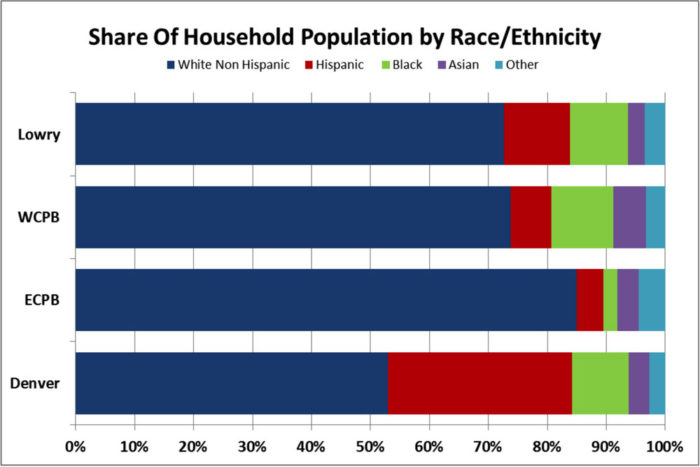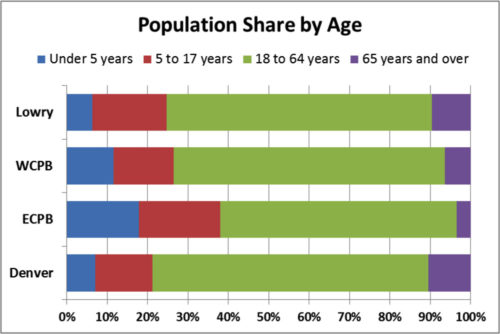
State Demographer Elizabeth Garner summed up her presentation on Stapleton demographics by saying, “We are definitely not close to average.” Garner, a Stapleton resident herself, had been asked by the Citizens Advisory Board (CAB) to provide a snapshot on such measures as race, ethnicity and income as CAB continues to track Stapleton’s performance in affordable housing. At CAB’s May meeting, she presented her analysis, which, at the request of the Front Porch, had been expanded to include numbers for Lowry, another large-scale, infill project approaching completion.

Garner’s major findings are no surprise to anyone familiar with Stapleton. By comparison to Denver and Colorado as a whole, Stapleton is very white, very young and very wealthy. The three charts above illustrate those comparisons, breaking out Stapleton’s numbers by its two census tracts: west of Central Park Blvd. (CPB) and east of CPB (tracts 41.07 and 41.06, respectively). (Census tracts are geographies defined by the U.S. Census Bureau used for collecting and reporting data). The Stapleton population is split roughly two-thirds east of CPB, one-third west of CPB.
Other findings are perhaps less obvious and may have more significance long-term for an issue like affordable housing:
Stapleton’s black population west of CPB mirrors Denver’s (both at 10%) but because the percentage east of CPB is so low (2%), Stapleton’s overall percentage has declined to 5% as Stapleton has developed west to east.
From a race/ethnicity perspective, the bigger discrepancy between Stapleton and the city as a whole is with Hispanics: 5% for Stapleton versus 31% for Denver.
Housing “tenure” numbers (renters vs. owners) show Denver and Lowry at roughly a 50-50 mix whereas Stapleton’s two tracts show a predominance of owners (61% for the west tract, 82% for the east tract).
Median gross rent west of CPB ($1,299) exceeds the Lowry ($1,168) and Denver ($913) numbers but east of CPB, the rents are much higher ($1,923). Note that rents include rented single-family homes.
These numbers suggest Stapleton will have an increasingly difficult challenge in meeting its affordable housing goals. With for-sale housing prices continuing to escalate, CAB views rental housing as a critical need, saying Stapleton’s development plan (the Green Book) calls for Forest City to make one-third of all housing rentals. Forest City has asserted it will meet its contractual requirement for 10 percent affordable for-sale units but has called the one-third rental number a “projection.”

Garner cautioned CAB to the limits of the numbers she was presenting. They are based on the American Community Survey (ACS) that is an annual statistical sample compiled by the Census Bureau. To obtain useful limits of probability based on sample size, the ACS numbers are presented as five-year averages. This means the “ACS 2010-14” numbers presented by Garner are lagging well behind existing conditions within Stapleton. The numbers do not include any of the considerable number of affordable housing projects under construction or scheduled to break ground in 2016 (see May 2016 Front Porch front page article “Construction Goes into High Gear”). These statistics put the total population at 13,455, a number that is over 22,000 today, according to Tom Gleason, VP for public relations, Forest City.
Nevertheless, the numbers do indicate trends that will need to be overcome in later stages of Stapleton development if it is to meet its affordable housing goals. Rising housing prices generally add to that challenge. Garner pointed out that the Denver population continued to increase through the recession even as housing starts fell off dramatically; less so in Stapleton. This has added to the upward pressure on housing costs. Regarding diversity in Stapleton, Garner said affordable housing helps because there is more diversity at the lower-income levels: it provides a “bigger pool that you are likely to be able to draw from.”
Click here to read Elizabeth Garner’s full PowerPoint presentation on demographics at Stapleton.




Uhhh, where’s the link to the PowerPoint?
Our apologies, it has been posted.